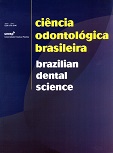In Vitro Study on the influence of the light polymerization technique and appliance on the bond strength of intra-radicular dowels
DOI:
https://doi.org/10.14295/bds.2012.v15i2.754Keywords:
Fiber post, Retention force, Direct method, Direct-indirect method, Halogen lamp, LED.Abstract
Purpose: The purpose of this study is to verify the influence of light curing type on retention force of direct technique and direct-indirect technique. Materials and Methods: Fourth bovine single root teeth with 12mm of length were used in this study. The roots were endodontically treated and randomly divided in four groups according to the light curing unit and technique used: group 1(direct technique, halogen lamp), group 2(direct technique, LED), group 3(direct-indirect technique, halogen lamp), group 4(direct-indirect technique, lamp). The retention force was determined sing a Universal Testing Machine (Instron). All data were analyzed using one-way analysis of variance (ANOVA) and Tukey test. After the test, the failure was examined and classified according to the fracture place: post/ resin; resin/dentin; mix.
Results: Group 3 (246,05N ± 29,51) and 4(241,60N ± 28,95)4 (95,18N) did not show statistically difference but presented higher retention force than group 1 (142,30N ± 25,60) and 2 (178,56N ± 25,67). Most of fracture occurred in interface between dentin/resin. Conclusion: Based on the obtained results, it was concluded that adhesive cementation technique influenced in the retention of glass fiber post.
Downloads
Downloads
Additional Files
Published
How to Cite
Issue
Section
License
Brazilian Dental Science uses the Creative Commons (CC-BY 4.0) license, thus preserving the integrity of articles in an open access environment. The journal allows the author to retain publishing rights without restrictions.
=================




























